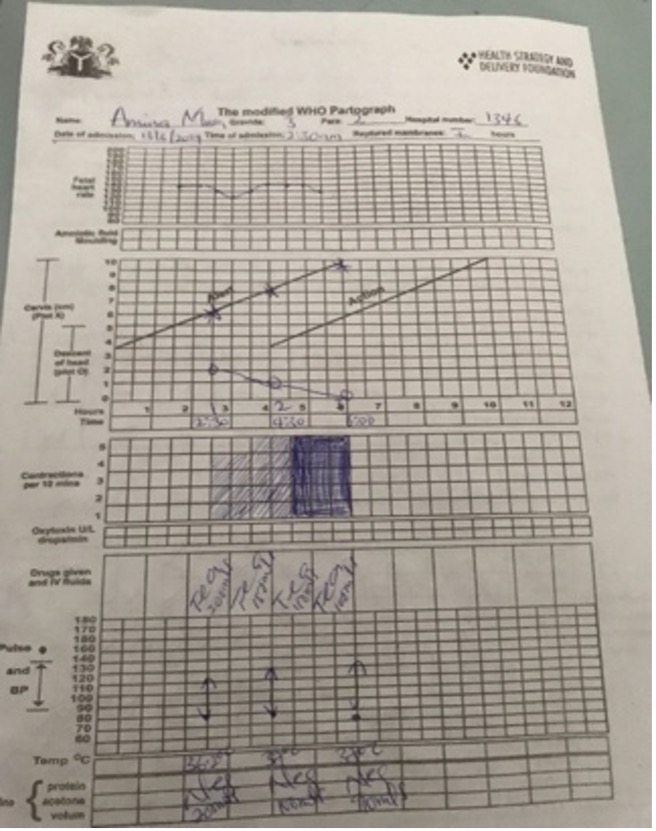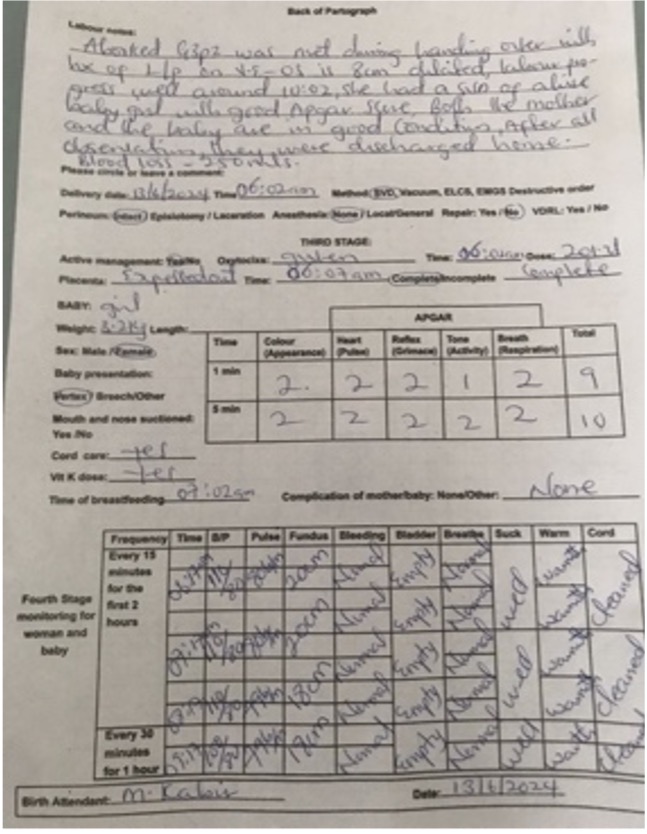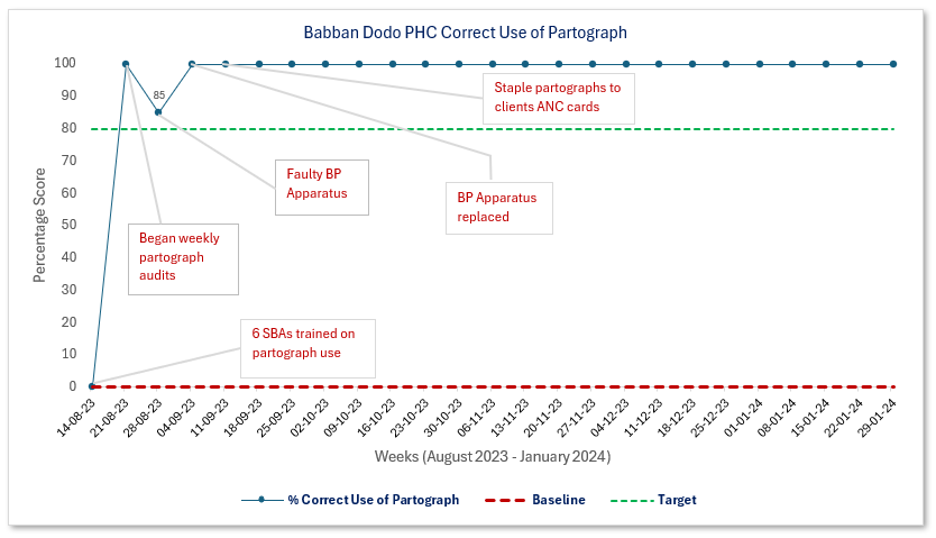Improved Monitoring of Labor and Delivery with the Use of Partograph: Spotlight on Babban Dodo Primary Health Centre, Zaria
Partograph training for Skilled Birth Attendants facilitated by Dr Hauwa Mahmud at Babban Dodo Primary Health Center.
Babban Dodo Primary Health Centre (PHC) is a busy facility nestled in the heart of a semi-urban community in Zaria LGA of Kaduna state. Despite the perennial challenge of an inadequate workforce and limited resources, coupled with local religious beliefs and cultural practices which fostered poor maternal health outcomes, the facility is renewing the hope for improved quality maternal care in its host community through the revival of a simple, yet, potentially lifesaving tool.
The partograph – a graphical representation of a pregnant mother’s labor and delivery progress- is an often overlooked and underutilized tool. First developed in 1972, it has for over five decades proved effective in predicting and averting adverse maternal and fetal health outcomes when correctly used. With the efforts of a dedicated facility leadership and a budding quality improvement (QI) team, Babban Dodo PHC has reprioritized the consistent and correct use of partograph at the Labor and Delivery Unit in a fresh effort to improve the quality of maternity care and reduce preventable maternal and neonatal deaths.
This improvement journey began with PROJECT AISHA’S implementation of the Maternal Healthcare Quality Improvement Learning Session (LS) workshops series. The name ‘Aisha’ means ‘alive and well’ which is the goal of the project –safer outcomes for pregnant mothers and their babies. During the LS workshops, Midwives, Nurses, Community Health Extension Workers (CHEWS) and Medical Records Officers receive training on quality improvement (QI) methods and tools and use the platform for peer learning and exchange of best practices. At this first LS workshop session in August 2023, participants enhanced their competency by learning the importance of the partograph and how to use it correctly to better monitor labor and improve outcomes.
Following the LS workshop, Babban Dodo PHC conducted a 6-week retrospective review and audit of patients’ delivery records to establish their baseline performance on the correct use of partograph. This audit was conducted using a standardized partograph scoring tool the QI team had received training on. For the partograph to be correctly used in monitoring labor and delivery, all the eligible components of care for each woman in labor need to have been provided and documented on the partograph. The median performance from these audits shaped the aim statement set for this prioritized clinical process to be tested in the PHC.
While the audits showed 50% of deliveries were monitored with a partograph, the quality of monitoring (correct use) was 0% at baseline, with none of the audited partograph meeting the standard care on the partograph scoring tool. Thus, the QI team agreed to achieve an increase in the correct use of partograph to monitor all labor and delivery cases from a baseline score of 0% to 80% within a 3-month period. To achieve this, the six skilled birth attendants in the facility were trained on the correct use of the partograph, ensured consistent availability of partographs, attachment of a partograph to the client’s ANC cards to promote adherence, and continuous monitoring of the newly adopted practice through weekly audits of delivery case notes.


Photos of a completed partograph used to monitor a delivery at PHC Babban Dodo
Since the start of this QI initiative in August 2023, weekly audits have been routinely conducted for all deliveries at the PHC to assess the correct use of partograph in monitoring labor and delivery which reached a total of 902 births over a 27-week period. Output from these audits was plotted on an annotated run chart to graphically represent the PHC’s improvement journey over this 27-week review period (see graph below).

Figure 1: An increase in the correct use of partograph over a 27-week period in Babban Dodo PHC in Zaria, Kaduna state
The graph shows a correct partograph utilization baseline score of 0% at Babban Dodo PHC in early August 2023. Following the training of 6 skilled birth attendants (SBAs) on correct partograph use during labor on August 14th, the facility recorded an astronomical improvement of 100% by the end of the first week of implementation. Two more change ideas (weekly partograph audits and stapling of partographs to ANC cards) were introduced in the succeeding four weeks to sustain the gains made. In week three, a decline to 85% was observed owing to a faulty blood pressure (BP) apparatus which prevented clients BP measurement during labor thus lowering audit scores for that week. Performance climbed back to 100% in week four owing to a timely replacement of the damaged BP device. This positive performance shift has since been sustained for over 21 weeks as a result of the facility’s permanent adoption of the change ideas.
The above data shows that since September 4, 2023, the correct use of partograph in Babban Dodo PHC is now a standard practice which has been sustained. The improved monitoring of pregnant women in labor and better management of the newborn in the immediate postpartum period is one of the direct impacts the correct use of partograph has had on the facility’s SBAs. There were no records of maternal, perinatal, or neonatal deaths during the 5-month period reviewed given the over 900 deliveries taken at the facility. Also, Skilled Birth Attendants (SBAs) have reported a boost in their confidence, and their capacity to detect complications promptly and accurately during labor and in the immediate post-partum period.
“Before project Aisha, we didn’t take documentation as serious as we do now. Now we use partograph for every delivery in this facility which helps us to early detect any obstruction or abnormality that may arise with more confidence and then make prompt referrals thereby saving both mother’s and baby’s life”.
Saadatu Salihu Gambo. PHC Manager. Babban Dodo PHC
Grants and Business Development Specialist
We are seeking a highly motivated and experienced Grants and Business Development Specialist to join our organization. The successful candidate will be responsible for identifying funding opportunities, developing grant proposals, and fostering partnerships with potential donors and stakeholders (regional and global). This role plays a vital part in securing funds and resources to support our organization’s mission and projects.
Apply NowPublic Health Consultant, Guinea
The consultant (working with the Accelerator team) will collect results from the tool, organize a meeting with stakeholders to discuss results from the tool, and produce a report on key findings and recommendations from the tool to be shared publicly.
Apply NowPublic Health Associate, Senegal
We are currently in search of an experienced Public Health professional in Senegal to work on the anticipated Nutrition Capacity Development and Financing Platform and provide technical assistance to elevate nutrition financing and strengthen local capacity to support these efforts. The Associate must be bilingual (English and French).
Apply Now